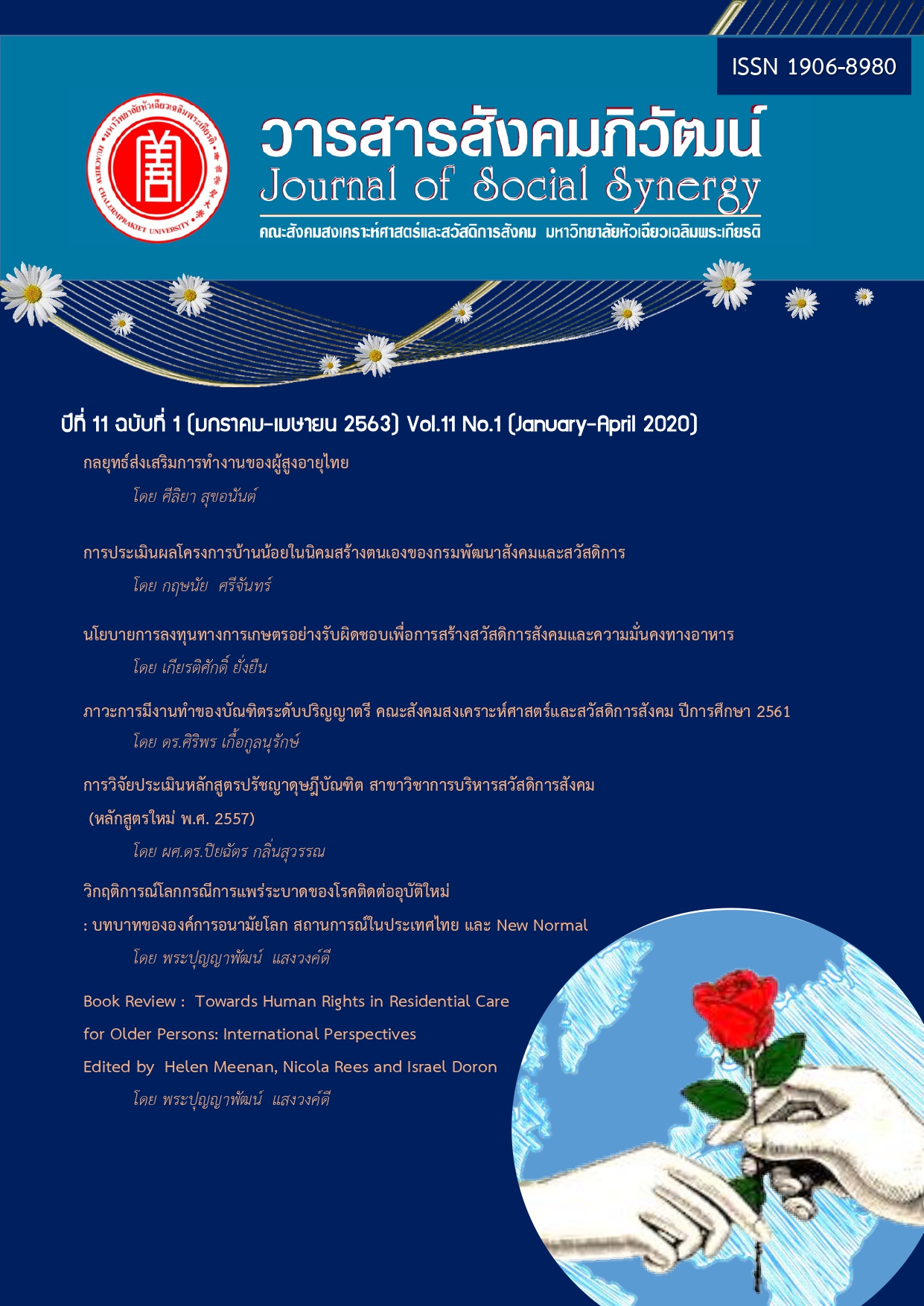An Evaluation of Baan Noi Project in a Self-Help Land Settlement of Department of Social Development and Welfare
Keywords:
Evaluation, Baan Noi in a settlement, Department of Social Development and WelfareAbstract
This research paper aims to present an Evaluation of Baan Noi Project in
a Self-Help Land Settlement of Department of Social Development and Welfare for evaluating the context or environment, input, process and product of the project according to CIPP Evaluation Model. Qualitative research through interview method was employed in this study. The population was 30 people from the working groups of Baan Noi Project in a settlement of pilot area such as Thungsan Self-Help Land Settlement in Pitsanulok province, Prasat Self-Help Land Settlement in Surin province; Lamtakong Self-Help Land Settlement in Nakhon Ratchasima province; Houyloung Self-Help Land Settlement in Udon Thani province and Prachuapkhirkhan Self-Help Land Settlement in Prachuapkhirkhan province. The result of the context evaluation revealed that the project policy aimed to support helpless persons to have occupation and send them back to the society sustainably. The input evaluation was planned to operate systematically. According to the process evaluation, project working group was appointed. The selection process and potential development of project members were also included. However, the limitation of this present study naturally includes resource development, for example, the insufficient budget to develop member potential and the areas for professional training could only be agriculture. According to the product evaluation, the results demonstrated that the target groups had occupation, the project can be carried out based on the specific time period, and the disbursement is within the allocated amount. In, further study, the Department of Social Development and Welfare should remove some lessons in order to develop them as a model to transfer knowledge to other areas, including the evaluation that aims to evaluate for development.
References
กาญจนา วัธนสุนทร. (2552). การประยุกต์ใช้รูปแบบการประเมิน CIPP ของสตัฟเฟิมบีม ในการประเมินโครงการทางการศึกษา. นนทบุรี : มหาวิทยาลัยสุโขทัยธรรมาธิราช.
ดุษฎี โยเหลา และคณะ. (2551). การวิจัยประเมินผลการดำเนินงานตามแผนกลยุทธ์ของมหาวิทยาลัย. กรุงเทพฯ : สถาบันวิจัยพฤติกรรมศาสตร์ มหาวิทยาลัยศรีนครินทรวิโรฒ.
ราชกิจจานุเบกษา. (2557). พระราชบัญญัติคุ้มครองคนไร้ที่พึ่ง พ.ศ.2557. สืบค้นเมื่อ 17 มิถุนายน 2559, จาก library2.parliament.go.th/giventake/...nla2557/law83-231257-1.pd...
ราชกิจจานุเบกษา. (2559). พระราชบัญญัติควบคุมการขอทาน พ.ศ.2559. สืบค้นเมื่อ 19 มิถุนายน 2559, จาก
http://web.krisdika.go.th/data/law/law2/%A407/%A407-20-2559-a0001.htm
ศุภามณ จันทร์สกุล. (2557). ยุคสมัยของการประเมินผลและแนวคิดทฤษฎีของนักประเมิน.วารสารวิชาการมหาวิทยาลัยอีสเทิร์นเอเชีย ฉบับวิทยาศาสตร์และเทคโนโลยี, 8(1), 68-79.
สถาบันพัฒนานโยบายและการจัดการ จุฬาลงกรณ์มหาวิทยาลัย. (2558). โครงการประเมินผลผลิต โครงการสำคัญและพัฒนาแผนยุทธศาสตร์ 5 ปี เพื่อเพิ่มประสิทธิภาพองค์การ กรมพัฒนาสังคมและสวัสดิการ ปี 2558. กรุงเทพฯ : กรมพัฒนาสังคมและสวัสดิการ กระทรวงการพัฒนาสังคมและความมั่นคงของมนุษย์.
Downloads
Published
How to Cite
Issue
Section
License
บทความที่ได้รับการตีพิมพ์เป็นลิขสิทธิ์ของวารสารสังคมภิวัฒน์ มหาวิทยาลัยหัวเฉียวเฉลิมพระเกียรติ
ข้อความที่ปรากฏในบทความแต่ละเรื่องในวารสารวิชาการเล่มนี้เป็นความคิดเห็นส่วนตัวของผู้เขียนแต่ละท่านไม่เกี่ยวข้องกับมหาวิทยาลัยหัวเฉียวเฉลิมพระเกียรติ และคณาจารย์ท่านอื่นๆในมหาวิทยาลัยฯ แต่อย่างใด ความรับผิดชอบองค์ประกอบทั้งหมดของบทความแต่ละเรื่องเป็นของผู้เขียนแต่ละท่าน หากมีความผิดพลาดใดๆ ผู้เขียนแต่ละท่านจะรับผิดชอบบทความของตนเองแต่ผู้เดียว




